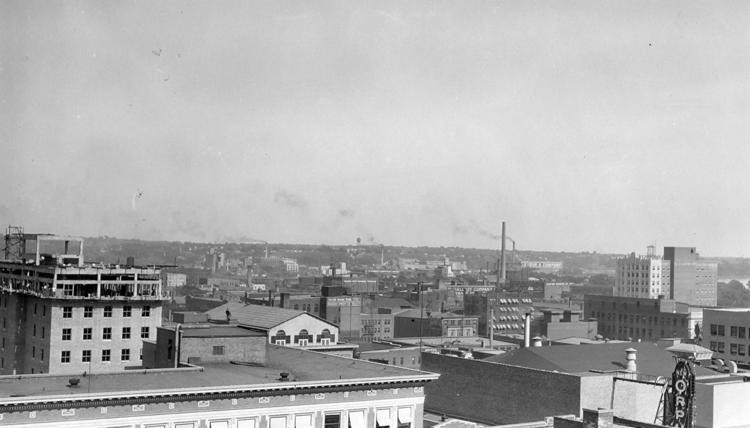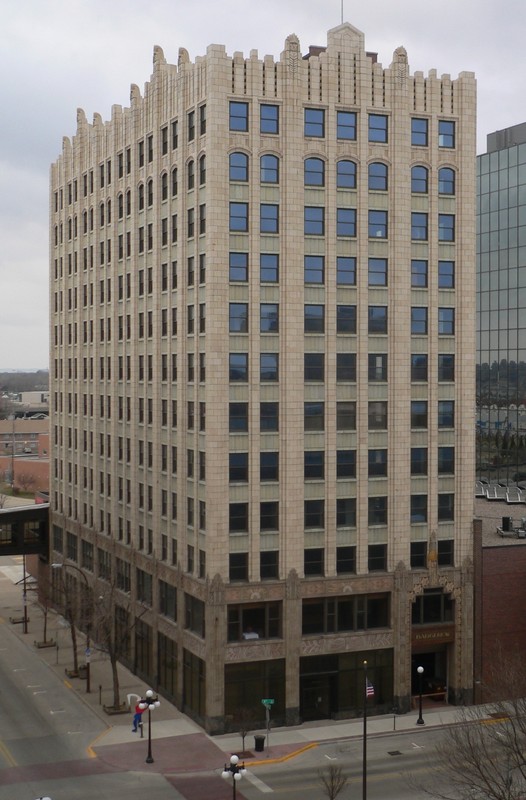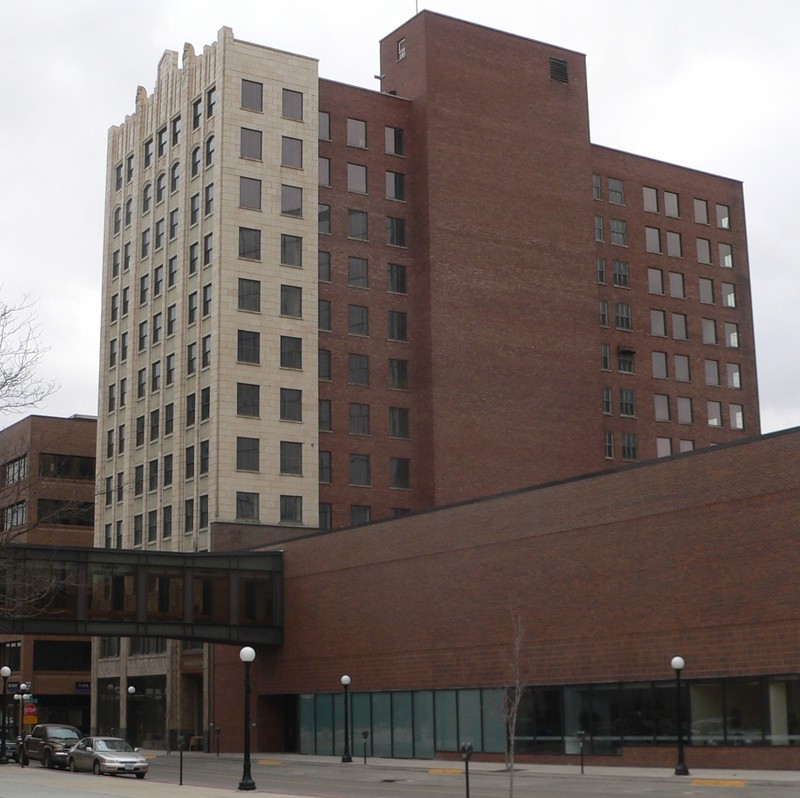Badgerow Building
Introduction
Text-to-speech Audio
Images
1930s Sioux City: The tall building in the distance, on the right, is the Badgerow Buidling. (The article is focused on the 1920s, but the building didn't get started until the 1930s, so the photo was obviously taken in the '30s)

Badgerow Building, located at southwest corner of 4th and Jackson Streets in Sioux City, Iowa; seen from the northeast.

Badgerow Building, located at southwest corner of 4th and Jackson Streets in Sioux City, Iowa; seen from the northwest

Backstory and Context
Text-to-speech Audio
Combining elements of the Sullivanesque, Moderne, Chicago, and Art Deco schools, the Badgerow is an excellent tribute to the regional interpretation of the Art Decor architectural style. The structure enjoys the nickname "Monarch of the City" and rises twelve stories (169 feet) into the sky, with only two of its facades (east and north) adorned with terra cotta. Formerly located on the corner of a vital commercials block, twentieth-century renewal cleared all but the Badgerow, exposing its brick party walls on its remaining west and south faces.
During the late 1920s, E.M. Badgerow sought to construct a modern office building to honor his father and one of Sioux City's pioneers, Gordon Ralph Badgerow. The elder Badgerow emigrated from Ontario, Canada in 1866 and moved to Sioux City in 1876. Gordon Badgerow practiced law, served as deputy internal revenue collector for northwest Iowa, Sioux City Postmaster, and made large investments in the Fourth Street business district of Sioux City. The junior Badgerow desired to pay homage to his father with the skyscraper, so he assembled investors that came to be known as the Jackson Street Building Company.
The group chose a plot of land at the geographical center of the residential section of the city. The plot enjoys a rich history as it was once the home of a steamboat captain's house, a pioneer Sunday School, two large department stores, one of which caught fire in 1904 and led to the burning of an entire city block. The Jackson Street Building Company hired Chicago's K.E. Westerland in 1929 to design the building and, despite the onset of the Great Depression, saw that design unfold from 1930-1933.
Chicago's highly acclaimed Louis Sullivan was one of the first architects to introduce the basic high rise building concept to the Midwest. Still, the Badgerow Building goes further in its attempt to "localize" the vertical building form with its striking ornamentation, variety of color, and modernized engineering. The walls of the lobby are comprised of Black Belgian marble and pink Tennessee marble while the floors have patterned terrazzo. A brochure published in the 1930s boasts of the building's modern design, a strategic location at the junction point for all streetcars, and superior elevator service.
A Native American head sits above the main entrance and along the parapet, meant to evoke the region's history. Indeed, the Yankton Sioux occupied the Sioux Land region until European fur trappers reached the area during the eighteenth century. In 1804, Lewis and Clark set-up camp near what would become Sioux City, Iowa, with the Omaha and Yankton Sioux nations nearby. Attempts to establish Sioux City failed in 1848, but the arrival of the first steamboat during the summer of 1856 came with materials used to build homes. Twelve years after that, in 1868, the railroad and a few small factories emerged, and then by 1873, the first large-scale meatpacking plant followed by stockyards in 1884. It was during that time when Gordon Ralph Badgerow arrived to Sioux City, and he helped the city develop its business district. In 1880 Sioux City had a population of 7,500. By 1890, the city could boast of 38,700 residents along with streetcars, waterworks, and electric lights.
By the 1920s, Sioux City stood as the nation's 99th largest city, with a population exceeding 75,000 by 1930. Just as the Sioux City enjoyed the fruits of its growth, the building and the Great Depression arrived. In many ways, the building speaks to the city's history but also marks a time when the city had reached its peak growth; its current population changed only slightly since the building opened.
Sources
Christian, Ralph. "Nomination Form: Badgerow Building." National Register of Historic Places. nps.gov. March 24, 1982. https://npgallery.nps.gov/GetAsset/1315f738-731a-4f4f-a3a4-8372034578b6
Dockter, Mason. "Sioux City population numbers almost unchanged in past 77 years.." Sioux City Journal (Sioux City) July 12, 2017. https://siouxcityjournal.com/coffee_break/sioux-city-population-numbers-almost-unchanged-in-past-77-years/article_54e32cc2-4687-58bb-9464-c21e43663e4c.htm
Lewis, Meriwether, William Clark, and Gunther Paul Barth. The Lewis and Clark Expedition: Selections from the Journals, Arranged by Topic. Boston: Bedford Books, 1998.
Sioux City History. Accessed April 23, 2020. http://www.siouxcityhistory.org/.
https://siouxcityjournal.com/news/local/decades-40-photos-looking-back-at-sioux-city-in-the-1920s/collection_2f7ed85c-44e0-5a6c-b65b-e36bc39eac8b.html#18
By Ammodramus - Own work, CC0, https://commons.wikimedia.org/w/index.php?curid=18942488
By Ammodramus - Own work, CC0, https://commons.wikimedia.org/w/index.php?curid=18942490
